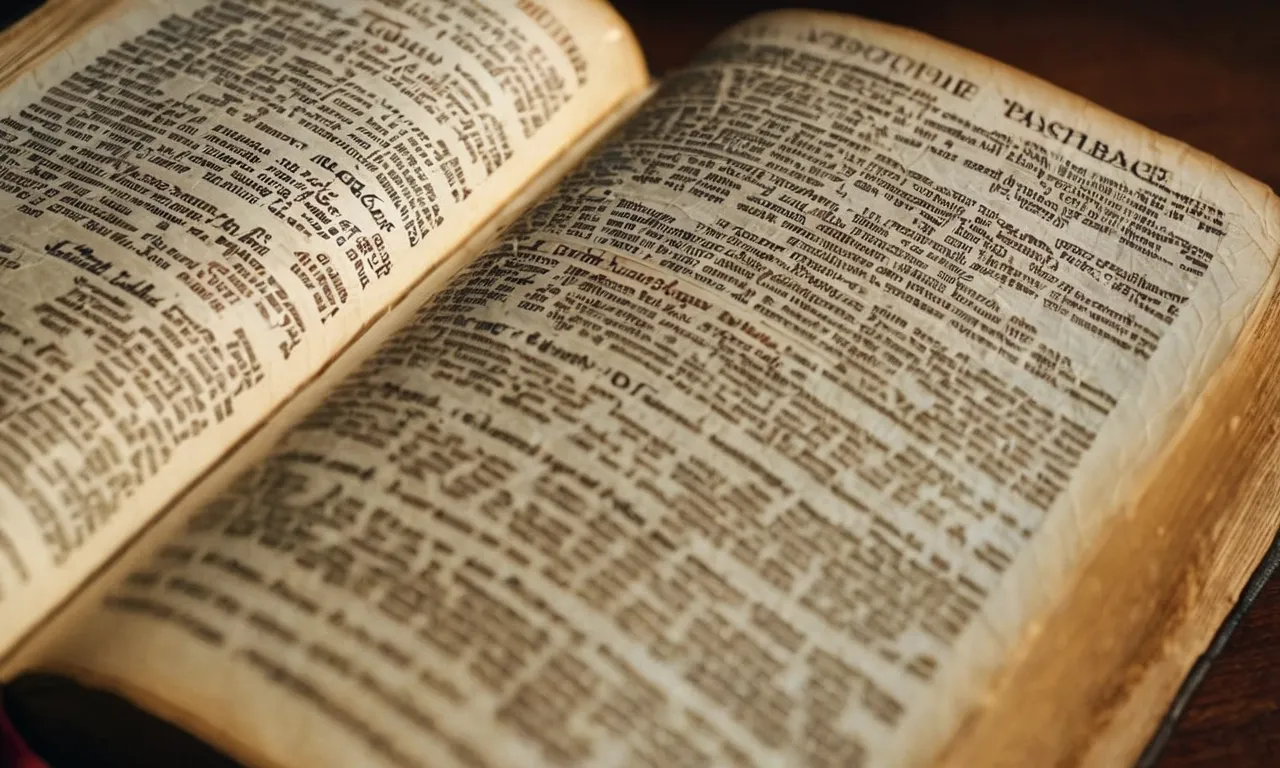The Purpose Of The Law In The Bible
The laws recorded in the Bible have been a source of curiosity and debate for centuries. Many wonder what their purpose is and why an all-knowing and loving God would implement such strict rules. If you’re short on time, here’s a quick answer to your question: The main purposes of the Old Testament laws were to set Israel apart from other nations, provide guidelines for worship and daily living, point to human sinfulness and need for a Savior, and foreshadow the coming of Christ.
In this comprehensive 3000 word article, we will explore the multiple purposes and functions of the Old Testament law. We will provide context by looking at the biblical and historical background. Then we will examine key passages in Exodus, Leviticus, and Deuteronomy that reveal insight into why God gave the law.
We will see how the laws pointed to human sinfulness and foreshadowed Christ’s redemption. And we will look at how Jesus and the New Testament writers interpreted and applied the Old Testament law.
Background of the Old Testament Law
The Giving of the Law at Mount Sinai
After God delivered the Israelites from slavery in Egypt through miraculous plagues and the parting of the Red Sea, He brought them to Mount Sinai around 1446 BC. There, God established a covenant with the Israelites and gave them the Law through Moses (Exodus 19-23).
This included the Ten Commandments as well as many additional laws and regulations for worship, sacrifices, social justice, and everyday life.
The Law served as the constitution for Israel as a nation. By obeying these laws, the Israelites would remain in right relationship with God and each other. The laws provided moral guidance and social order in addition to setting Israel apart from other nations.
Giving the Law on Mount Sinai was a pivotal moment establishing Israel’s special status as God’s chosen people.
Three Types of Laws
The Law given to Moses consists of over 600 statutes covering civil, ceremonial, and moral regulations:
- Civil laws provided the legal system for Israel’s theocracy, dealing with penalties for crimes, property, contracts, and other regulations for an orderly society.
- Ceremonial laws governed Israel’s system of worship, sacrifices, special days, dietary restrictions, and purification rituals that set them apart as holy to the Lord.
- Moral laws included the Ten Commandments and addressed practical ways to love God and neighbor in real life situations.
Each category worked together as a whole, guiding Israel’s relationship with God and each other across all areas of life. Obedience demonstrated their faith while disobedience required sacrifices and other remedies.
Old Covenant Versus New Covenant
The Mosaic Law represented an older covenant between God and Israel prior Jesus Christ’s life, death, and resurrection. The New Covenant established through Christ offers a new basis for relationship with God through faith rather than strict adherence to the law (Luke 22:20; Hebrews 8:7-13).
However, the moral laws in the Old Testament, especially the Ten Commandments, reflect God’s unchanging righteousness and remain relevant as examples of holy living.
As theologian Wayne Grudem explains, “The Ceremonial law clearly does not apply because Christ fulfilled it as the gospel teaches. The civil law does not apply because that was the law of the Old Testament nation of Israel. But the moral law does still apply because it reflects God’s character.”
So while parts of Old Testament law do not directly apply today, we can still learn much about God’s priorities through studying the Law He gave at Mount Sinai.
Purposes of the Old Testament Law
To Set Israel Apart
One of the main purposes of the Old Testament law was to set the nation of Israel apart from the surrounding nations as God’s chosen people (Exodus 19:5-6). The extensive laws regarding worship, diet, dress, agriculture, and social practices were designed to distinguish Israel from her pagan neighbors.
The laws reflected God’s holy character and were a means by which the people were set apart to worship Him. As Moses told the Israelites, “Obey the laws and teachings I’m giving you today, and you will live…The Lord wanted to show you that he is the only true God and that he can keep his promise to bless you” (Deuteronomy 4:1,35).
By following God’s law, the Israelites were visibly separated from other cultures as God’s treasured people.
To Provide Guidance for Worship and Daily Living
The Old Testament law provided the Israelites with instructions for how to properly worship God and live their daily lives in a way that honored Him. The extensive rituals and sacrifices taught the seriousness of sin and the need for confession, atonement, and cleansing from impurity.
Laws regarding the Sabbath, annual feasts, tithes, diet, farming practices, justice, marriage, and business promoted social harmony and care for the poor. As Moses told the people, “Always remember these commands I am giving you today… Repeat them again and again to your children.
Talk about them when you are at home and when you are on the road, when you are going to bed and when you are getting up” (Deuteronomy 6:6-7). The Old Testament law guided the Israelites into holy living that reflected the holy God they served.
To Reveal Sin and the Need for a Savior
A third purpose of the Old Testament law was to reveal human sinfulness and the need for a Savior. As the apostle Paul wrote, “No one can ever be made right with God by doing what the law commands. The law simply shows us how sinful we are” (Romans 3:20).
The Israelites quickly demonstrated that they could not perfectly keep God’s law, as seen by the repeated biblical stories of their rebellion and idolatry. The sacrificial system did not permanently atone for sin either but was a reminder of sins committed (Hebrews 10:3).
As Paul explained, the law was meant to lead people to Christ by showing their need for redemption (Galatians 3:24). It is only through Jesus’ atoning sacrificial death on the cross that sin can be forgiven and eternal life granted by God’s grace, not by works of the law.
To Foreshadow Christ
Finally, the Old Testament law contains many foreshadowings and “pictures” of the promised Messiah Jesus Christ. As Jesus said, “The Scriptures point to me!” (John 5:39). The Passover lamb and scapegoat sacrifices foreshadowed Christ’s sacrificial death for sin (1 Corinthians 5:7).
The manna from heaven and water from the rock provided sustenance and refreshment, as Jesus is the bread and living water that give eternal life (John 6:35). The high priest interceding for the people foreshadowed Christ as our great High Priest who intercedes for us (Hebrews 4:14).
The tabernacle and temple were pictures of Christ dwelling among His people (John 1:14). The Old Testament law not only had purposes for Israel, but it all pointed ahead to the coming of the Messiah who would fulfill the law and inaugurate the new covenant by His life, death, and resurrection.
How Jesus Fulfilled and Reinterpreted the Law
Jesus’ Teachings in the Sermon on the Mount
In the Sermon on the Mount, Jesus makes it clear that He did not come to abolish the Law, but to fulfill it (Matthew 5:17). At the same time, Jesus goes beyond the literal interpretation of the Law and calls people to its spiritual intent.
For example, Jesus says that anger towards someone is like murder, and lust is like adultery (Matthew 5:21-30). Jesus is calling us to evaluate our hearts and not just our outward actions. The purpose of the Law is to shape our hearts to be more like God, who is loving and righteous.
How Jesus Went Beyond the Letter of the Law
One example of how Jesus fulfilled the Law beyond its literal meaning is in Matthew 12:1-14. Here the Pharisees criticized Jesus and His disciples for picking grain on the Sabbath. But Jesus argues that caring for human needs supersedes the ceremonial observance of the Sabbath.
As Lord of the Sabbath, Jesus reinterprets strict Sabbath laws in light of God’s mercy. Other examples are Jesus’ healings on the Sabbath, and His defense of eating with unwashed hands (Mark 3:1-6, Matthew 15:1-20).
Jesus goes beyond surface level obedience to highlight the deeper spiritual purpose behind God’s commands.
Paul and Other NT Writers on the Purpose of the Law
The apostle Paul explains that the purpose of the Law is to expose our sin, so that we turn to Christ (Galatians 3:19-29). Paul also says that Christ is the fulfillment and end of the Law to all who believe (Romans 10:4). Believers are not under the Law, but under grace (Romans 6:14-15).
The Law brings knowledge of sin, while faith in Christ brings justification (Romans 3:20-22). Still, Paul and other NT writers affirm the value of God’s Law when interpreted properly. For example, Romans 13:8-10 emphasizes loving one’s neighbor as fulfilling the intent of the Law.
Conclusion
In summary, the Old Testament law served many important purposes in God’s plan. It set Israel apart, provided practical guidelines for living, revealed the sinfulness of man, and pointed ahead to salvation through Christ.
While Christians are no longer under the Old Covenant law, we can still learn much about God’s holy character and appreciate how the law prepared the way for Christ.








